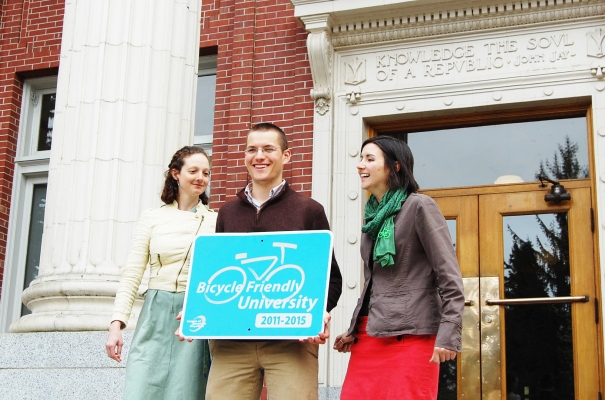University of Oregon among bike elite, but could improve, visiting speaker says

When the executive director of the League of American Bicyclists came to Eugene May 5, the University of Oregon LiveMove transportation student group gave him more than just a photo opportunity in front of Johnson Hall. They took him out bicycling.
Equipped with a bicycle from the University of Oregon Bike Program, Andy Clarke toured Eugene’s bicycle network before returning to campus. He hit some of the bicycling hot spots: the Willamette River bicycle-and-pedestrian bridges, the Alder Street contraflow bike lane, the bike box at Seventh Avenue and High Street, and 13th Avenue.
There, Clarke presented the university with the League’s Bicycle Friendly University Silver award. In the most recent application process, Clarke said, 33 universities applied for bike-friendly status, with only two-thirds achieving bronze or higher.
Eugene has a decades-long history cycling activism that has paid off, Clarke said. At the University of Oregon, 17 percent of students and faculty now use a bicycle to get to campus. “That’s high,” Clarke said, “but that could probably be twice that number if you really put your minds to it.”
University President Richard Lariviere took up the challenge. “We expect you back, Andy, with a gold or platinum award,” he told Clarke.
After the presentation, the LiveMove Speaker Series hosted Clarke for a free public lecture on promoting cycling and building on the university’s leadership. OTREC funding supports the LiveMove student group.
Of the barriers to cycling—literal as well as figurative—none really justifies continued dependence on automobiles, Clarke said, before listing several. There’s enough money for bicycle improvements, for example. “You’re spending money in the community on transportation,” he said. “You’re repaving and resurfacing streets.
“There’s not really a lack of money,” he said. “It’s a question of priority and how you spend that money that’s holding us back.”
Clarke disputed another frequently cited barrier to cycling: that we’re a car-loving society. “We don’t’ have a love affair with the car,” he said. “We have a love affair with the cheapest, most convenient way of getting around, and we’ve made that the car.”
That’s not the case elsewhere, as with much of Europe. “In Copenhagen, cycling is a quick, easy, convenient, cheap way of getting around, so people do it,” Clarke said. “They don’t do it because they’re a cyclist; they do it because it just works.”
